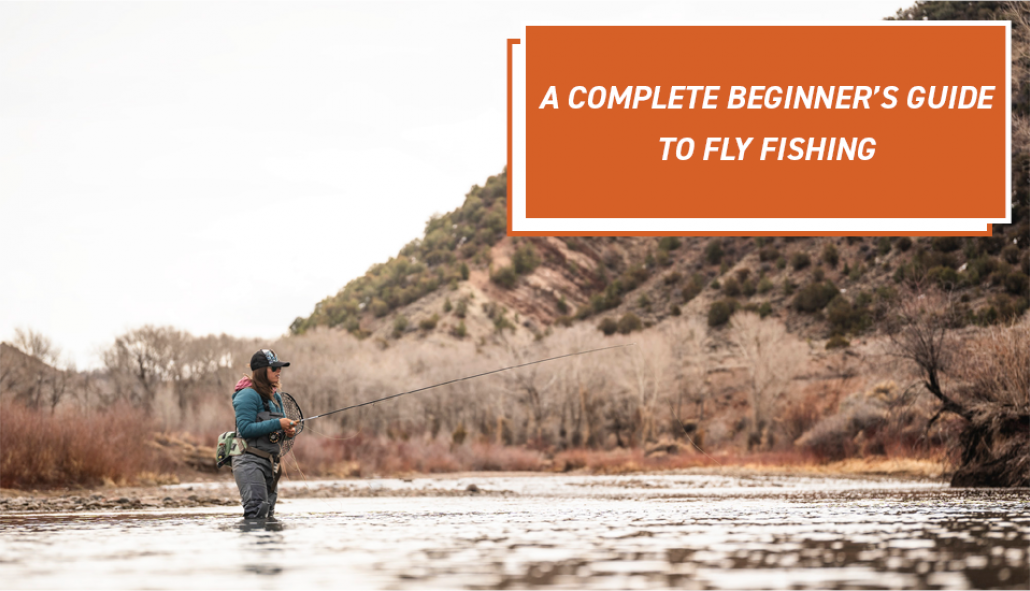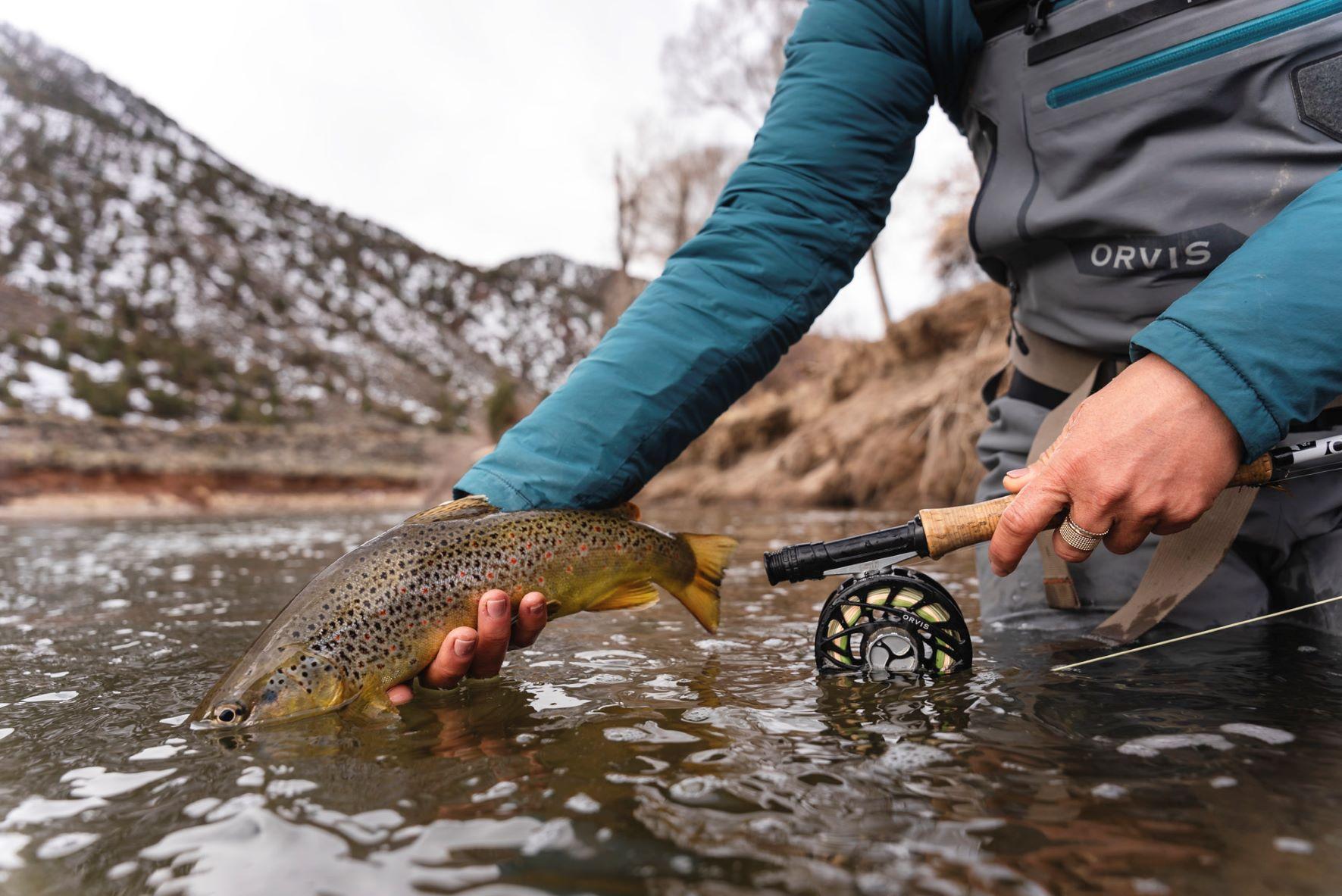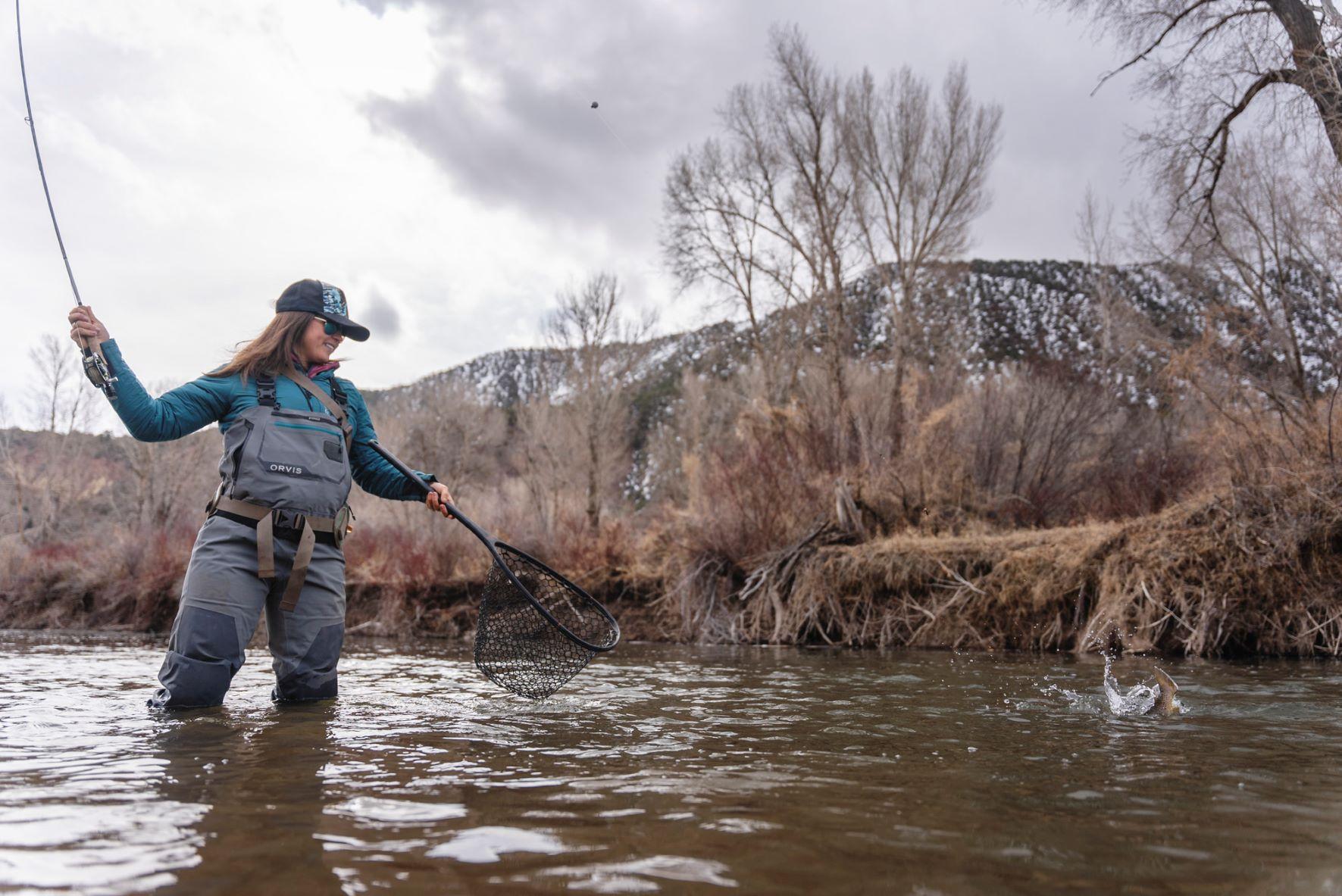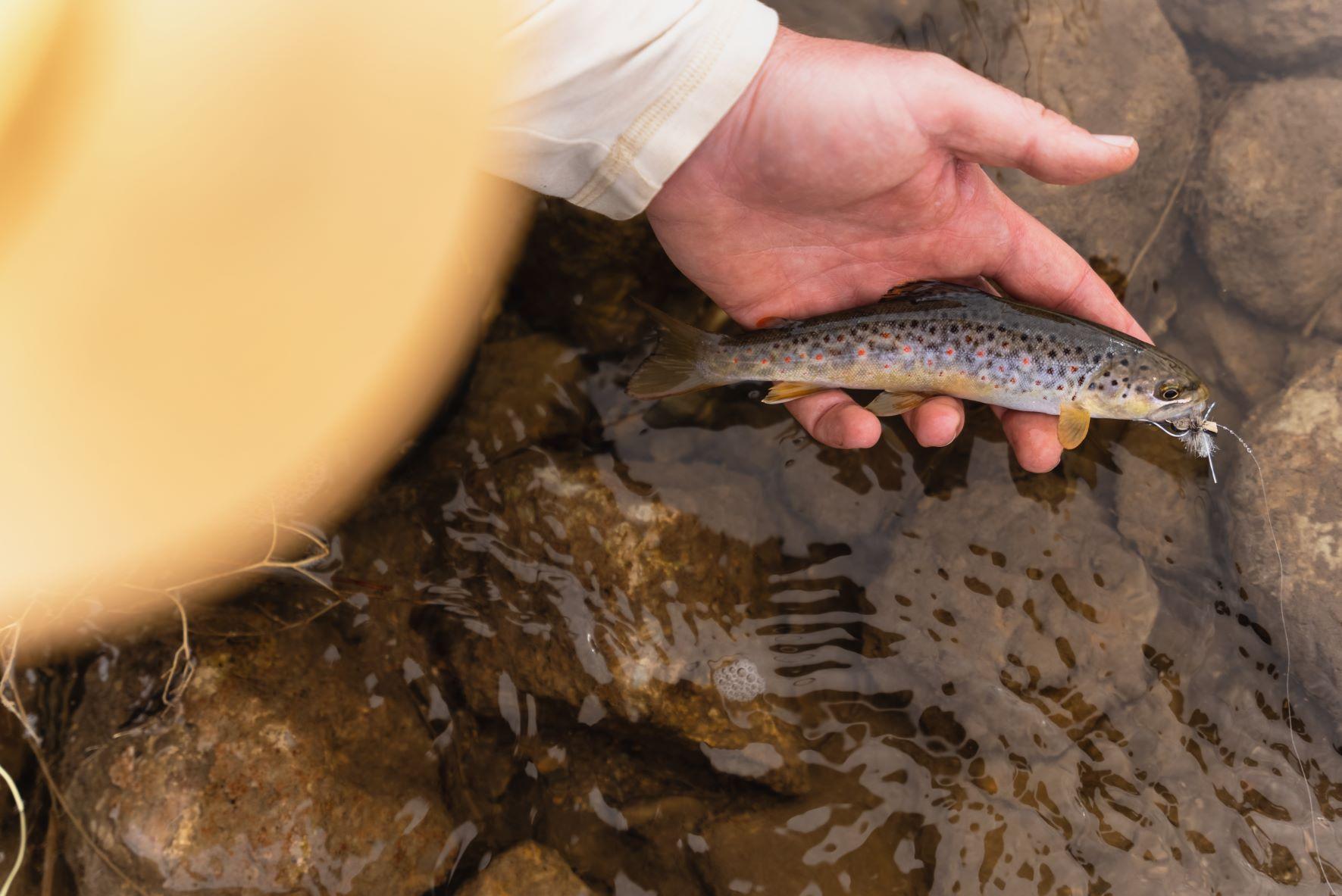Gear
With the fundamental differences between fly fishing and conventional methods of fishing out of the way, let’s move on to some basic knowledge that you will need about the gear you are going to be using on your next fly fishing adventure.
For an overview of beginner's gear, check out Fly Fishing: A Beginners Gear List.
If you're ballin' on a budget, check out Budget Fly Fishing Setup for Beginners.
The Rod
A fly fishing rod is designed differently than a conventional fishing rod and is made specifically for fly fishing. While we could do a deep dive into the complexity and nuances of the construction of a fly fishing rod, we’re going to stick with our theme of keeping this Beginner’s Guide to Fly Fishing simple.
Here’s what you need to know: fly fishing rods are usually longer and more flexible than conventional fishing rods. The average fly rod is nine feet long. Fly fishing rods also come in different sizes than conventional fishing rods. Generally speaking, most fly fishing rod manufacturers make rods in sizes 2-12. A note about fly fishing rods: the size of the fly fishing rod is known as the “weight,” of the rod. Though there are rods made by companies outside of that range, those are the most commonly produced weights of fly fishing rods.
“So what do the weights of the rods mean?” you might ask. It’s actually pretty intuitive. The higher the number associated with the weight of the rod, the stronger the rod. For example, a two-weight rod is much less strong than a ten-weight rod. Typically, rod size directly correlates with the species of fish that you would like to fish for. However, that does not mean overlap between certain species does not exist. Generally speaking, if you want to learn the basics of fly fishing for trout, you will want to use a nine-foot, five-weight fly fishing rod. If you are interested in fishing for other species of fish but have questions regarding which size rod you will need for your adventure, the staff here at Trouts Fly Fishing have the answers you need.
If you decide to go the fly fishing combo kit route, check out our article on Fly Fishing Outfits.
The Reel
If at this point you’re thinking that fly fishing reels are unique to fly fishing, then you’re correct. Just like the rods, fly fishing reels are made specifically for fly fishing. Fly fishing reels are designed to only work with fly fishing rods and fly fishing lines. Fly reels are designed to complement the casting techniques used in fly fishing and to accommodate the larger diameter of lines. Like fly fishing rods, fly reels come in different sizes. Unlike fly fishing rods, fly reels come in sizes that accommodate a range of fly fishing rod sizes. For example, if you are using a five-weight rod for trout fishing, you will likely be using a 3-5 or 4-6 size reel. What these numbers mean is that they can accommodate fly fishing line sizes between 3-5 or 4-6. Spoiler alert: fly fishing line sizes directly correspond to the weight of the rod. Don’t worry, we’ll get to fly fishing lines a little later in this Beginner’s Guide to Fly Fishing. All in due time, friend.
Like conventional fishing reels, fly reels are often equipped with a drag. You might be wondering what a “drag,” is. Simply put, it is the mechanism in a reel that allows you to apply pressure against the fish pulling your line on the other end. Essentially, the drag helps the angler maintain control over the fish.
Similar to fly fishing rods, the size of the reel is determined by the species of fish that you are targeting. While more overlap exists between the desired species of fish and the size of the reel, you will want to stick to a reel size that is appropriate for the weight of your fly fishing rod and line. Like fly rods, fly reels are made to accommodate specific amounts of stress and abuse. What we’re saying is, you wouldn’t want to use a trout-sized reel to take on any species of saltwater fish and vice versa. Just like we mentioned in the section about fly fishing rods if you have questions about which size of reel you need for a specific fish, we’re here to help.
Make sure to read our article about the three best fly reels for under $300.
The Line
Fly fishing line, like almost all other aspects of fly fishing gear, can become somewhat convoluted if you perform enough Google searches. However, the fly line is one of the easier components to understand. First and foremost, choose a line size that corresponds to the weight of the rod. Just like fly rods, lines come in “weights”. Got a five-weight rod? You need a five-weight line. Pretty simple, right?
If you are sitting there thinking that choosing a line is the easiest part of acquiring the necessary gear for your first fly fishing adventure, you’re mostly right. Fly fishing lines are tapered, as are most things in the world of fly fishing. This taper helps to slow the transfer of kinetic energy as you cast. Without a taper, your line would hit the water with so much force that fish in the immediate area would be too scared to eat the delicious-looking flies that you have carefully selected. In fly fishing, we call this “spooking” the fish. Now, there are different tapers depending on which fly line you select. If you’re sticking with our nine-foot, five-weight rod suggestion for targeting trout, we recommend a five-weight, floating trout-specific fly line.
Hold up, there are sinking lines? Well, there are actually a few different types of fly lines. There are floating lines, sinking lines, and intermediate lines. Moreover, there are distinct differences between fly lines made for use in freshwater and fly lines made for use in saltwater. However, as a beginner, we recommend that you start with a good ole freshwater, five-weight, floating line to go along with your five-weight fly rod as we mentioned earlier.
For more information, check out our Understanding Fly Lines article.
Leader vs. Tippet
Fly fishing leaders and tippets are one of the more complex, yet fundamental, aspects of gear that you need to understand as a beginner. Choosing the right leader and tippet can ultimately affect your chances of success on your first excursion, but what exactly are a leader and a tippet? Don’t fret, it’s not all that serious. With that said, the following is the gist of what you need to know.
What is a leader? Essentially, the leader is a piece of tapered fishing line that connects the ends of your fly line to your fly. If you were to somehow tie a fly onto the end of your fly line, you wouldn’t be able to place your fly in the desired location with precision or delicacy. Usually, a leader is nine feet long. The general rule of thumb is that you should match the length of your leader to the length of your fly rod.
So what is a tippet? Well, the tippet is the last section of your leader where the taper ends. So why do you need a spool of tippet material? As you inevitably change flies or break them off when they get stuck in trees (it happens to the best of us) throughout the course of the day, your leader is going to get shorter with each fly change. Thus, you use tippet material to rebuild your leader.
With that out of the way, leader and tippet come in different sizes. Leader and tippet sizes are represented by a number followed by the letter “x”. For example, sizes are labeled as 3x, 4x, 5x, and so on. Unlike the rods and reels, leader and tippet sizes use a descending order regarding strength. Basically, the lower the number, the stronger and thicker in diameter the leader and tippet. We know... why can’t all the sizes in fly fishing be ordered the same way? It’s a complicated story, so don’t shoot the messenger. We’re trying to keep this simple, remember?
There are two common types of leader and tippet material. There is nylon and there is fluorocarbon. What’s the difference? Glad you asked. The short story is that one floats and one sinks. Which kind of flies you choose will determine which material you will want to use (I promise, we will eventually get to flies). We recommend that you match your leader material and your tippet material, at least to start. Yeah, yeah, yeah... you’re right, there’s certainly more that can be unpacked here, but that’s what you need to know to get started.
If you want to learn more about the knots and rigging involved with leader and tippet, check out our knots & rigging page in our learning center, which has a plethora of how-to videos that will walk you through the information and techniques that you need to know to get started fly fishing.







